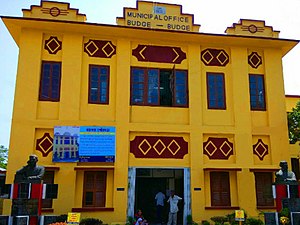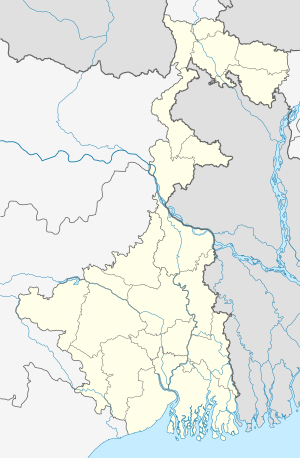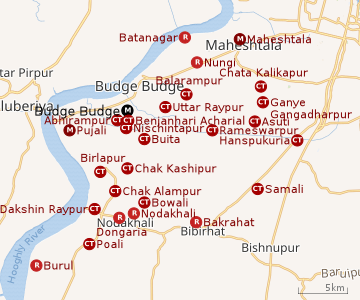Budge Budge
Budge Budge is a city and a municipality of the South 24 Parganas district in the Indian state of West Bengal. It is situated on the eastern banks of the Hooghly River. It is a part of the area covered by the Kolkata Metropolitan Development Authority (KMDA).[3]
Budge Budge | |
|---|---|
City | |
 Budge Budge Municipality | |
 Budge Budge Location in West Bengal  Budge Budge Location in India | |
| Coordinates: 22.4650°N 88.1682°E | |
| Country | |
| State | West Bengal |
| Division | Presidency |
| District | South 24 Parganas |
| Region | Greater Kolkata |
| Government | |
| • Type | Municipality |
| • Body | Budge Budge Municipality |
| Area | |
| • Total | 9.06 km2 (3.50 sq mi) |
| Elevation | 9 m (30 ft) |
| Population (2011) | |
| • Total | 76,837 |
| • Density | 8,500/km2 (22,000/sq mi) |
| Languages | |
| • Official | Bengali[1][2] |
| • Additional official | English[1] |
| Time zone | UTC+5:30 (IST) |
| PIN | 700137 |
| Telephone code | +91 33 |
| Vehicle registration | WB-19 to WB-22, WB-95 to WB-99 |
| Lok Sabha constituency | Diamond Harbour |
| Vidhan Sabha constituency | Budge Budge |
| Website | www |
History
Hindu dharmic leader Swami Vivekananda landed at Budge Budge ferry ghat in 1897 when he returned from his Chicago visit. The anniversary is still celebrated on 19 February with great zeal. The old railway station from where he boarded the train to Calcutta is decorated with flowers on this day. The waiting room where he rested for a while is preserved.
Budge Budge was the site where the ship Komagata Maru was allowed to land following its return from Vancouver. The ship was chartered by a group of Sikhs to challenge the exclusion laws enacted by Canada to restrict Indian immigration. Upon entry into the harbour, the ship was stopped by a British gunboat, and the passengers were placed under guard. The government of the British Raj saw the men on the Komagata Maru not only as self-confessed lawbreakers, but also as dangerous political agitators. When the ship docked at Budge Budge, the police went to arrest Baba Gurdit Singh and the 20 or so other men that they saw as leaders. He resisted arrest, a friend of his assaulted a policeman and a general riot ensued. Shots were fired and 19 of the passengers were killed. Some escaped, but the remainder were arrested and imprisoned or sent to their villages and kept under village arrest for the duration of the First World War. This incident became known as the Budge Budge Riot.
Historically the oldest people of this city were the 'Haldars' who came here to guard a fort near the bank of the River Ganges. A British writer who had come with Clive around 1740-50 chronicled this event. Maniklal was the main person at the fort and his soldiers lost to Clive's troops.
Geography
 |
| Cities and towns in the western part of Alipore Sadar subdivision (including Budge Budge I & II, Thakurpukur Maheshtala CD blocks) in South 24 Parganas district M: municipal city/ town, CT: census town, R: rural/ urban centre, Owing to space constraints in the small map, the actual locations in a larger map may vary slightly Bakrahat is in Bishnupur II CD block, but Lakshmibala Rural Hospital at Bakrahat serves Budge Budge II CD block and so it is included here. |
Area overview
Alipore Sadar subdivision is the most urbanized part of the South 24 Parganas district. 59.85% of the population lives in the urban areas and 40.15% lives in the rural areas. In the northern portion of the subdivision (shown in the map alongside) there are 21 census towns. The entire district is situated in the Ganges Delta and the subdivision, on the east bank of the Hooghly River, is an alluvial stretch, with industrial development.[4][5][6]
Note: The map alongside presents some of the notable locations in the subdivision. All places marked in the map are linked in the larger full screen map.
Location
Budge Budge is located at 22°27′54″N 88°10′06″E. It has an average elevation of 9 metres (30 ft).[7]
Balarampur, Uttar Raypur, Buita, Benjanhari Acharial, Abhirampur and Nischintapur form a cluster of census towns around Budge Budge and Pujali, as per the map of the Budge Budge I CD block on the page number 167 in the District Census Handbook 2011 for the South 24 Parganas district.[8]
Climate
Köppen-Geiger climate classification system classifies its climate as tropical wet and dry (Aw).
| Climate data for Budge Budge | |||||||||||||
|---|---|---|---|---|---|---|---|---|---|---|---|---|---|
| Month | Jan | Feb | Mar | Apr | May | Jun | Jul | Aug | Sep | Oct | Nov | Dec | Year |
| Average high °C (°F) | 25.4 (77.7) |
27.7 (81.9) |
31.4 (88.5) |
33.1 (91.6) |
33.4 (92.1) |
32.3 (90.1) |
30.7 (87.3) |
30.8 (87.4) |
31.2 (88.2) |
30.8 (87.4) |
28.1 (82.6) |
25.1 (77.2) |
30.0 (86.0) |
| Daily mean °C (°F) | 19.9 (67.8) |
22.7 (72.9) |
27 (81) |
29.3 (84.7) |
30 (86) |
29.5 (85.1) |
28.5 (83.3) |
28.6 (83.5) |
28.5 (83.3) |
27.5 (81.5) |
23.5 (74.3) |
20 (68) |
26.3 (79.3) |
| Average low °C (°F) | 14.5 (58.1) |
17.7 (63.9) |
22.6 (72.7) |
25.6 (78.1) |
26.7 (80.1) |
26.8 (80.2) |
26.4 (79.5) |
26.4 (79.5) |
25.9 (78.6) |
24.2 (75.6) |
19 (66) |
14.6 (58.3) |
22.5 (72.6) |
| Average precipitation mm (inches) | 14 (0.6) |
17 (0.7) |
20 (0.8) |
34 (1.3) |
96 (3.8) |
244 (9.6) |
323 (12.7) |
322 (12.7) |
321 (12.6) |
172 (6.8) |
30 (1.2) |
1 (0.0) |
1,594 (62.8) |
| Source: Climate-Data.org (altitude: 9m)[9] | |||||||||||||
Demographics
| Population of Budge Budge | |||
|---|---|---|---|
| Census | Population | %± | |
| 1901 | 13,051 | — | |
| 1911 | 17,982 | 37.8% | |
| 1921 | 25,723 | 43.0% | |
| 1931 | 24,183 | −6.0% | |
| 1941 | 32,394 | 34.0% | |
| 1951 | 32,196 | −0.6% | |
| 1961 | 39,824 | 23.7% | |
| 1971 | 51,039 | 28.2% | |
| 1981 | 70,404 | 37.9% | |
| 1991 | 77,575 | 10.2% | |
| 2001 | 81,554 | 5.1% | |
| 2011 | 76,837 | −5.8% | |
| Source:[10] | |||
According to the 2011 Census of India, Budge Budge had a total population of 76,837, of which 39,510 were males and 37,327 were females. There were 6,946 people in the age range of 0 to 6 years. The total number of literate people was 59,504, which constituted 77.4% of the population with male literacy of 81.2% and female literacy of 73.5%. The effective literacy (7+) of population over 6 years of age was 85.1%, of which male literacy rate was 89.1% and female literacy rate was 81.0%. The Scheduled Castes and Scheduled Tribes population was 7,015 and 103 respectively. Budge Budge had a total of 18,055 households as of 2011.[11]
According to the 2001 Census of India, Budge Budge had a total population of 81,554. Males constitute 55% of the population and females 45%. It has an average literacy rate of 70%, higher than the national average of 59.5%: male literacy is 75%, and female literacy is 64%. 10% of the population is under 6 years of age.[12]
Kolkata Urban Agglomeration
The following municipalities and census towns in the South 24 Parganas district were part of the Kolkata Urban Agglomeration in the 2011 census: Maheshtala (M), Joka (CT), Balarampur (CT), Chata Kalikapur (CT), Budge Budge (M), Nischintapur (CT), Uttar Raypur (CT), Pujali (M) and Rajpur Sonarpur (M).[13]
Civic administration
Municipality
Budge Budge Municipality covers an area of 9.06 km2 (3.50 sq mi). It has jurisdiction over parts of the Budge Budge. The municipality was established in 1900. It is divided into 20 wards. According to the 2015 municipal election, it is being controlled by the All India Trinamool Congress.[14]
Police station
Budge Budge police station covers an area of 49.61 km2 (19.15 sq mi). It has jurisdiction over parts of the Budge Budge and Pujali municipalities, and the Budge Budge I and Budge Budge II CD blocks.[15][16]
Economy
Over the past few years Budge Budge has developed considerably in terms of lifestyle and infrastructure. With the ongoing projects like Calcutta Riverside, widening of the Budge Budge Trunk (BBT) Road and the starting of the 7.7 km Batanagar Flyover from Jinjira Bazar to Batanagar;[17] the economy of this city is expected to get a major boost.
Budge Budge owes much of its importance to the port, oil storage and jute mills. Being close to Kolkata and on the shores of the Hooghly River makes it a strategic location for oil storage and is the biggest oil storage for the metropolis Calcutta with big PSUs like Petroleum Wharves Budge Budge under Kolkata Port Trust. BPCL, HPCL, IOC having large units there. Jute mills were the biggest employers in the area till they started falling sick. Prominent among them are New Central Jute Mill and Budge Budge Jute Mills. At their height before 1971 these jute mills used to employ thousands of workers (New Central Jute Mills has been said to have employed as many as twenty thousand people) but after the partition of India and the subsequent creation of Bangladesh, supply of raw materials for these jute mills decreased. This, along with failure of trade unions lead to the closing of most of these jute mills.
The Budge Budge Thermal Power Station set up by CESC in Achipur (named after a Chinese called Achhu saheb by the locals who had established a sugar cane unit there) is a major source of electricity for Kolkata and its suburbs.
Transport
Budge Budge is on the Budge Budge Trunk Road.[18]
Budge Budge railway station is on the Sealdah–Budge Budge line of the Kolkata Suburban Railway system.[18][19]
Commuters
With the electrification of the railways, suburban traffic has grown tremendously since the 1960s. As of 2005-06, more than 1.7 million (17 lakhs) commuters use the Kolkata Suburban Railway system daily. After the partition of India, refugees from East Pakistan/ Bangladesh had a strong impact on the development of urban areas in the periphery of Kolkata. The new immigrants depended on Kolkata for their livelihood, thus increasing the number of commuters. Eastern Railway runs 1,272 EMU trains daily.[20]
Education
Budge Budge College, established in 1971, is affiliated with the University of Calcutta. It offers honours courses in Bengali, English, Sanskrit, history, political science, philosophy, economics, geography, education, mathematics and accounting & finance, and general degree courses in arts, science, and accounting & finance.[21]
Budge Budge Institute of Technology, established in 2009, offers diploma, undergraduate and postgraduate degree courses in Engineering and Technology and other allied fields.[22][23]
Budge Budge P K High School is a Bengali-medium school for boys. It was established in 1903 and has facilities for teaching from class V to class XII.[24]
Budge Budge Abbey High School is a Bengali-medium school for boys. It was established in 1891 and has facilities for teaching from class V to class X.[25]
Budge Budge Uchha Balika Vidyalaya Up High School is a Bengali-medium school for girls. It was established in 1948 and has facilities for teaching from class V to class XII.[26]
Budge Budge Subhash Girls High School is a Bengali-medium school for girls. It was established in 1971 and has facilities for teaching from class V to class X.[27]
Budge Budge Sahu Jain Vidyalaya Up School is a Hindi-medium coeducational school. It was established in 1966 and has facilities for teaching from class V to class VIII.[28]
Badamtala High School is a Bengali-medium coeducational school. It was established in 1973 and has facilities for teaching from class V to class XII.[29]
Kalipur High School is a Bengali-medium school for boys. It was established in 1919 and has facilities for teaching from class V to class XII.[30]
St Stephens School is an English-medium coeducational school. It was established in 2007 and has facilities for teaching from class V to class XII.[31]
Healthcare
Budge Budge ESI Hospital, with 300 beds, is the major government medical facility in the Budge Budge.[32]
References
- "Fact and Figures". Wb.gov.in. Retrieved 5 July 2019.
- "52nd REPORT OF THE COMMISSIONER FOR LINGUISTIC MINORITIES IN INDIA" (PDF). Nclm.nic.in. Ministry of Minority Affairs. p. 85. Archived from the original (PDF) on 25 May 2017. Retrieved 5 July 2019.
- "Base Map of Kolkata Metropolitan area". Kolkata Metropolitan Development Authority. Archived from the original on 28 September 2007. Retrieved 3 September 2007.
- "District Statistical Handbook 2014 South Twety-four Parganas". Table 2.1 , 2.2, 2.4b. Department of Statistics and Programme Implementation, Government of West Bengal. Retrieved 5 December 2019.
- "Census of India 2011, West Bengal, District Census Handbook, South Twentyfour Parganas, Series – 20, Part XII-A, Village and Town Directory" (PDF). Page 13, Physiography. Directorate of Census Operations, West Bengal. Retrieved 5 December 2019.
- "District Human Development Report: South 24 Parganas". Chapter 9: Sundarbans and the Remote Islanders, p 290-311. Development & Planning Department, Government of West Bengal, 2009. Archived from the original on 5 October 2016. Retrieved 5 December 2019.
- Falling Rain Genomics, Inc - Budge Budge
- "District Census Handbook South Twentyfour Parganas, Census of India 2011, Series 20, Part XII A" (PDF). Page 167 – Map of Budge Budge I CD block. Directorate of Census Operations, West Bengal. Retrieved 24 September 2019.
- "Climate: Budge Budge". Climate Data. Retrieved 14 January 2014.
- "District Census Handbook North Twenty Four Parganas, Census of India 2011, Series 20, Part XII A" (PDF). Section II Town Directory, Pages 781-783 Statement I: Growth History, Pages 799-803. Directorate of Census Operations V, West Bengal. Retrieved 12 December 2019.
- "Census of India: Budge Budge". www.censusindia.gov.in. Retrieved 27 April 2016.
- "Census of India 2001: Data from the 2001 Census, including cities, villages and towns (Provisional)". Census Commission of India. Archived from the original on 16 June 2004. Retrieved 1 November 2008.
- "Provisional Population Totals, Census of India 2011" (PDF). Constituents of Urban Agglomeration Having Population Above 1 Lakh. Census of India 2011. Retrieved 7 November 2019.
- "Budge Budge Municipality". Department of Municipal Affairs. Government of West Bengal. Archived from the original on 21 April 2017. Retrieved 18 May 2015.
- "Budge Budge police station". Diamond Harbour police district. West Bengal police. Retrieved 17 October 2019.
- "District Statistical Handbook 2014 South 24 Parganas". Table No. 2.1. Department of Statistics and Programme Implementation, Government of West Bengal. Retrieved 17 October 2019.
- Batanagar flyover @ TOI Jan 2014
- Google maps
- "34112 Sealdah – Budge Budge Local". Time Table. India Rail Info. Retrieved 3 November 2019.
- Mondal, Bhaswati. "Commuting and Metropolitan Development of Kolkata". ResearchGate. Retrieved 29 December 2019.
- "Budge Budge College". BBC. Retrieved 25 October 2019.
- "Budge Budge Institute of Technology". BBIT. Retrieved 29 October 2019.
- "Budge Budge Institute of Technology". CollegeDunia. Retrieved 29 October 2019.
- "Budge Budge P K High School". ICBSE. Retrieved 3 November 2019.
- "Budge Budge Abbey High School". ICBSE. Retrieved 3 November 2019.
- "Budge Budge Uchha Balika Vidyalaya Up High School". ICBSE. Retrieved 3 November 2019.
- "Budge Budge Subhash Girls High School". ICBSE. Retrieved 3 November 2019.
- "Budge Budge Sahu Jain Vidyalaya Up School". ICBSE. Retrieved 3 November 2019.
- "Badamtala High School". ICBSE. Retrieved 3 November 2019.
- "Kalipur High School". ICBSE. Retrieved 3 November 2019.
- "St Stephens School". ICBSE. Retrieved 3 November 2019.
- "Health & Family Welfare Department" (PDF). Health Statistics - Hospitals. Government of West Bengal. Retrieved 17 December 2019.
External links
